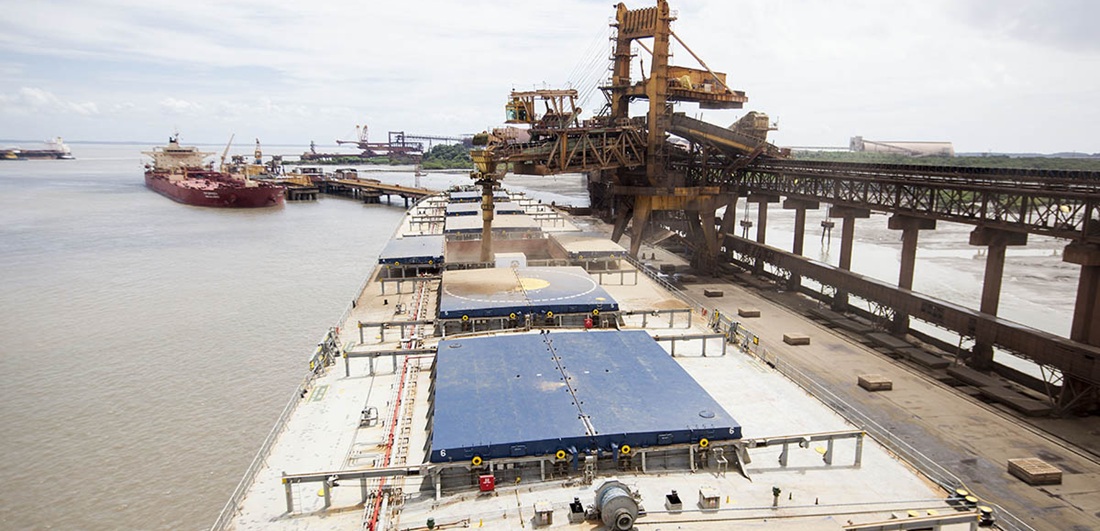
VLI Optimizes Cargo Throughput at São Luís Port Terminal with Air Draft Initiative
Feb, 11, 2025 Posted by Gabriel MalheirosWeek 202506
Multimodal logistics company VLI is celebrating the success of its Air Draft initiative at the São Luís Port Terminal (TPSL) in the Port of Itaqui. Designed to streamline deballasting and expedite berth turnover, the initiative has enabled more vessels to be loaded—especially during peak harvest months from May to August—boosting terminal productivity and overall cargo throughput.
“The implementation of the Air Draft initiative demonstrates how innovation drives continuous improvement at VLI, delivering tangible benefits to our customers’ supply chains. Our efficient operations in São Luís reinforce the importance of Maranhão’s port system and the VLI-operated Northern Corridor in Brazil’s export landscape,” said Ederson Almeida, VLI’s Director of Operations for the Northern Corridor.
In July 2024, TPSL set a new record, handling 718,000 tonnes of grain—a 4.35% increase over the same period last year. This was the terminal’s highest volume since VLI began operations in 2013, with a significant portion of this growth attributed to the improved efficiency brought by the Air Draft initiative.
The initiative allows vessels to arrive with less ballast water in their tanks, located between the hull and cargo holds to provide stability. This increases the vessel’s air draft, which is the maximum height above the waterline.
One key benefit is that vessels have a limited deballasting capacity, often lower than the terminal’s loading capacity. On average, the port can load three times more cargo per hour than the vessel’s ballast pumps can offload, creating a bottleneck in operations.
By arriving with reduced ballast, vessels can be loaded faster. However, precise calculations are required to ensure vessels remain within the port’s permissible height limits. Proper ballast management during loading is crucial for both structural safety and operational efficiency.
To accommodate the initiative, key loading infrastructure was upgraded, including modifications to the loading spout, which was extended to 16.6 meters. Previously, vessels docking at Berth 105 needed to maintain a ballast level that kept their height at or below 15 meters, the previous operational limit.
Additionally, the port’s nautical operations team began using VLI’s proprietary Speed System (Ship Loading and Unloading Planning System) to develop optimized loading plans that account for the required Air Draft upon docking.
Under this new system, ship captains adjust ballast levels before arriving at the port—previously, deballasting occurred after docking, delaying loading operations and reducing the flow of cargo. By shifting this process to the pre-arrival phase, vessel turnaround times have been significantly improved.
The optimization has led to substantial gains in port efficiency, reducing vessel loading times and maximizing asset utilization. Since the initiative’s implementation, vessel operation times at the Port of Itaqui have been cut by up to 14 hours.
Encouraged by the success at TPSL, VLI plans to expand the Air Draft initiative to other port terminals, including the Luiz Antonio Mesquita Integrator Terminal in the Baixada Santista, the General Cargo Terminal at the Tubarão Complex in Vitória (ES), and the Inácio Barbosa Maritime Terminal (TMIB) in Barra de Coqueiros, Sergipe.
The Northern Corridor’s Role in Brazilian Logistics
VLI’s Northern Corridor plays a critical role in shipping grain from the Matopiba region (Maranhão, Tocantins, Piauí, and Bahia), as well as from Mato Grosso, Pará, and Goiás via the São Luís Port Terminal. In addition to grain, the corridor handles fuel, pulp, fertilizers, and minerals.
The corridor’s logistics network includes three integrator terminals in Porto Nacional, Palmeirante (Tocantins), and Porto Franco (Maranhão). These hubs facilitate the transfer of cargo from road to rail, addressing one of Brazil’s major logistics challenges: storage capacity constraints.
-
Sugar and Ethanol
Aug, 26, 2024
0
Positive outlook for Brazil’s sugar exports
-
Other Logistics
Jan, 20, 2019
0
ANTT publishes the final report for the Ferrogrão Railway concession
-
Grains
Jan, 09, 2025
0
Argentina’s soy belt may be in for an alarmingly dry January
-
Shipping
Oct, 04, 2024
0
Houthi Attacks in Red Sea Disrupt Global Container Shipping Market

